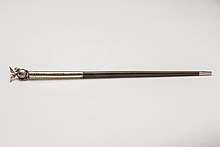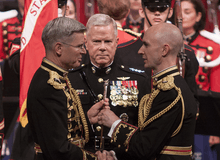John Philip Sousa Baton
The John Philip Sousa Baton is a conducting baton considered the symbol of the authority of the directorate of the United States Marine Band "The President's Own". It is traditionally passed from outgoing to incoming directors of the band at change of command ceremonies; when not in use it is held at the National Museum of the Marine Corps. The baton was originally a gift given to John Philip Sousa on the occasion of his 1892 retirement.


Description
The John Philip Sousa Baton is an approximately 17.15-inch (436 mm) wooden conducting baton capped with a silver engraving depicting the United States Marine Corps' Eagle, Globe, and Anchor emblem and finished in silver at the opposite end.[1] Along the side of the bottom is engraved the words "John Philip Sousa—presented by members of the U.S. Marine Band as a token of their respect and esteem. July 29, 1892".[1]
History
In 1892, John Philip Sousa announced his retirement as director of the United States Marine Band, "The President's Own", following twelve years as the ensemble's director during which, according to historian Paul E. Bierley, he developed it into "the finest military band in the world".[2] On July 29 of that year, Sousa directed the band in a penultimate concert at the National Theater, Vice President of the United States Levi Morton and Speaker of the United States House of Representatives Charles Frederick Crisp among those dignitaries in attendance.[1] At the conclusion of one number, cornetist William F. Smith approached Sousa and presented him with the baton. Sousa accepted the baton and used it to conduct two final pieces: "Approach and Retreat of the Salvation Army" and "Hail, Columbia".[1]
The next day, July 30, Sousa led the band in its final performance under his leadership, at the White House for President of the United States Benjamin Harrison following which he was officially discharged from service.[1] The last piece Sousa used the baton to conduct, while leader of the Marine Band, was "Hail, Columbia".[1]
Sousa died in 1932 and, in 1953, his daughters donated the baton to the U.S. Marine Band.[3] Since that time it has been passed from director to director of the band during change of command ceremonies and is considered the symbol of the directorate.[3][4] It is otherwise held at the National Museum of the Marine Corps.[5]
In popular culture
The baton figures in the plot of the 2011 juvenile novel by Martha Freeman, The Case of the Rock 'n Roll Dog.[6] According to Kirkus Reviews, the book centers on a "concert [that] is jeopardized when, among other items, the John Philip Sousa baton used by the Marine Corps Band goes missing."[6]
See also
References
- Robinson, Emily (September 27, 2017). "The March King Steps Down". WETA-FM. Retrieved August 2, 2019.
- Bierley, Paul. "John Philip Sousa". loc.gov. Library of Congress. Retrieved August 2, 2019.
- Bierley, Paul (1973). John Philip Sousa: American Phenomenon (Revised Edition). Alfred Music. pp. 55–56, 79. ISBN 1457449951.
- ""The President's Own" United States Marine Band Colonel Jason K. Fettig, Director". marineband.mil. U.S. Marine Corps. Retrieved August 2, 2019.
- "Collections". usmcmuseum.com. National Museum of the Marine Corps. Retrieved August 3, 2019.
- "The Case of the Rock 'N Roll Dog". Kirkus Reviews. Retrieved August 2, 2019.